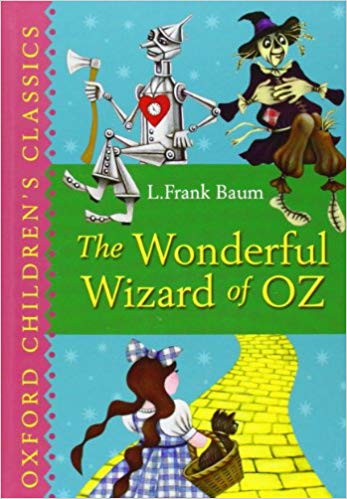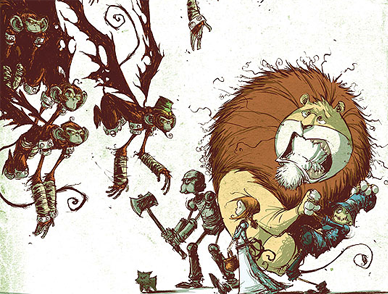 During the 2017-2018 teaching year I taught a complex group of grade 4/5 learners, most ELL, and many with behavioural, learning, and social-emotional challenges. In term 3 our class was invited to the local high school’s production of The Wizard of Oz. This invitation sparked an idea; to create an integrated unit using the story of The Wizard of Oz as the glue. My passion, training, and background in film allowed me to jump in with both feet to try to engage this diverse group of learners by using my own talents and by bringing my “art into the classroom regardless of what that art is” (Leland, Lewison & Harste, 2012, p.136).
During the 2017-2018 teaching year I taught a complex group of grade 4/5 learners, most ELL, and many with behavioural, learning, and social-emotional challenges. In term 3 our class was invited to the local high school’s production of The Wizard of Oz. This invitation sparked an idea; to create an integrated unit using the story of The Wizard of Oz as the glue. My passion, training, and background in film allowed me to jump in with both feet to try to engage this diverse group of learners by using my own talents and by bringing my “art into the classroom regardless of what that art is” (Leland, Lewison & Harste, 2012, p.136).
I had no idea at the time that I was engaging in teaching multimodal literacy. Although the term multimodal is new to me, I have been incorporating many aspects of multimodal literacy into my classroom since my early teaching days. In creating The Wizard of Oz unit, I recognized that my class loved being read to, and loved using technology, so I decided to start by building off what my students already knew and then use the technology “to tap into the students’ world by making learning new, current, and fun” (Leland, Lewison & Harste, 2012, p.138).
 The integrated unit included teaching two core competencies (Creative Thinking and Personal Awareness & Responsibility), several curriculum subject areas (Language Arts, ADST, and Fine Arts), and curriculum competencies and content from each subject area (“Building Student Success – BC’s New Curriculum”, 2018). By using a variety of forms and formats (technology, art, music, drama, and language) I hoped even my most challenging students would be engaged with the material and contribute to the conversation.
The integrated unit included teaching two core competencies (Creative Thinking and Personal Awareness & Responsibility), several curriculum subject areas (Language Arts, ADST, and Fine Arts), and curriculum competencies and content from each subject area (“Building Student Success – BC’s New Curriculum”, 2018). By using a variety of forms and formats (technology, art, music, drama, and language) I hoped even my most challenging students would be engaged with the material and contribute to the conversation.
The Wizard of Oz Integrated Unit (a brief description)
- Read aloud The Wizard of Oz original text by Frank L. Baum: Students listened to daily readings of the story over several weeks.
- Teach “Reading Film” basics: Students learned how different camera shots, angles, and movements “tell” the viewer how to interpret the story in the film.
- Storyboarding: Students used their knowledge of basic film techniques to retell the story of The Wizard of Oz using storyboarding sketches and brief summaries.
- Graphic Novel (based on the original text): Students viewed an illustrated graphic novel of the story to identify the correlation between graphic novels, storyboarding, and film (and the importance of visual elements in storytelling).
- Picture Book (based on the original text): Students viewed a picture book version of the story and compared and contrasted it to the novel and graphic novel.
- View The Wizard of Oz 1939 film: Students viewed the film over several class periods, keeping in mind the technological advances and limitations of the time period. They were spellbound by the story and loved comparing it to the original text. We discussed at length why the director might had made changes to the story and the impact of music on the story.
- Watch a live production of The Wizard of Oz: Before seeing the play, student identified parts of the story they thought would be challenging to produce in a live play and gave solutions for each. They were truly mesmerized and engaged in each moment while watching the play. The following day we discussed the play at length.
- Create a Wizard of Oz iMovie Trailer: Students worked in groups to create iMovie trailers of The Wizard of Oz incorporating green screen technology and using camera shots, angles, and movement (based on the original story or a creative version). Through the iMovie trailer project students had an opportunity to showcase all their learning by combining drama, oral language, text, music, visual & film literacy, and technology into one assignment.

The Result
Allowing time for both instruction and exploration of each of the multiple forms and formats used in this integrated unit brought student engagement at all learning levels. Students who were more reluctant, or found difficulty in one form or format, often showed interest and success in another. The term Transmediation – described as “The process of moving between and among language and art, language and music, and other ways of knowing” (Leland, Lewison & Harste, 2012, p.127), -created dynamic learning opportunities in the classroom. I agree that “multimodal responses are more than a nice ‘extra’ in our literacy program. In some cases, they provide the means for students to create new identities and get their voices heard” (Leland, Lewison & Harste, 2012, p.128).
Next Steps of Integration
 I now realize, that although I have been using multimodal learning in my classroom, there are many new avenues for me to explore in this area (especially when considering multiple perspectives surrounding complex social issues). Multimodal literacy can be used “to promote particular kinds of interaction, response, discussion, and retention, all of which are multimodal as all are print forms and digital formats that convey the text” (Delvecchio, 2018). Although I have dug deep, there is so much more to uncover in multimodal literacy.
I now realize, that although I have been using multimodal learning in my classroom, there are many new avenues for me to explore in this area (especially when considering multiple perspectives surrounding complex social issues). Multimodal literacy can be used “to promote particular kinds of interaction, response, discussion, and retention, all of which are multimodal as all are print forms and digital formats that convey the text” (Delvecchio, 2018). Although I have dug deep, there is so much more to uncover in multimodal literacy.
References
Building Student Success – BC’s New Curriculum. (2018). Retrieved July 11, 2018 from https://curriculum.gov.bc.ca/
Delvecchio, J. (2018). LLED 441: Module 3: A Snapshot of Language and Literature [Lecture Notes]. Retrieved from https://canvas.ubc.ca
Leland, C., Lewison, M., & Harste, J. (2012). Multimodal responses to literature. In Teaching children’s literature: It’s critical. Taylor and Francis, p. 125-236.
Multimodal literacy. (2018). Retrieved July 12, 2018 from https://www.education.vic.gov.au/school/teachers/teachingresources/discipline/english/literacy/readingviewing/Pages/litfocusmultimodal.aspx

Leave a comment